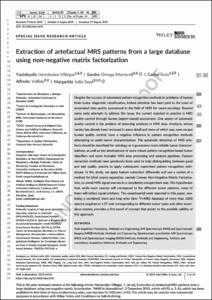Mostra el registre d'ítem simple
Extraction of artefactual MRS patterns from a large database using non-negative matrix factorization
| dc.contributor.author | Hernández Villegas, Yanisleydis |
| dc.contributor.author | Ortega Martorell, Sandra |
| dc.contributor.author | Arus Caraltó, Carles |
| dc.contributor.author | Vellido Alcacena, Alfredo |
| dc.contributor.author | Julia Sape, Margarida |
| dc.contributor.other | Universitat Politècnica de Catalunya. Departament de Ciències de la Computació |
| dc.date.accessioned | 2020-02-20T12:02:00Z |
| dc.date.available | 2020-12-02T01:33:18Z |
| dc.date.issued | 2022-04 |
| dc.identifier.citation | Hernández-Villegas, Y. [et al.]. Extraction of artefactual MRS patterns from a large database using non-negative matrix factorization. "NMR in biomedicine", Abril 2022, vol. 35, núm. 4, article e4193. |
| dc.identifier.issn | 0952-3480 |
| dc.identifier.uri | http://hdl.handle.net/2117/178175 |
| dc.description.abstract | Despite the success of automated pattern recognition methods in problems of human brain tumor diagnostic classification, limited attention has been paid to the issue of automated data quality assessment in the field of MRS for neuro-oncology. Beyond some early attempts to address this issue, the current standard in practice is MRS quality control through human (expert-based) assessment. One aspect of automatic quality control is the problem of detecting artefacts in MRS data. Artefacts, whose variety has already been reviewed in some detail and some of which may even escape human quality control, have a negative influence in pattern recognition methods attempting to assist tumor characterization. The automatic detection of MRS artefacts should be beneficial for radiology as it guarantees more reliable tumor characterizations, as well as the development of more robust pattern recognition-based tumor classifiers and more trustable MRS data processing and analysis pipelines. Feature extraction methods have previously been used to help distinguishing between good and bad quality spectra to apply subsequent supervised pattern recognition techniques. In this study, we apply feature extraction differently and use a variant of a method for blind source separation, namely Convex Non-Negative Matrix Factorization, to unveil MRS signal sources in a completely unsupervised way. We hypothesize that, while most sources will correspond to the different tumor patterns, some of them will reflect signal artefacts. The experimental work reported in this paper, analyzing a combined short and long echo time 1H-MRS database of more than 2000 spectra acquired at 1.5T and corresponding to different tumor types and other anomalous masses, provides a first proof of concept that points to the possible validity of this approach. |
| dc.format.extent | 16 p. |
| dc.language.iso | eng |
| dc.subject | Àrees temàtiques de la UPC::Informàtica::Aplicacions de la informàtica::Bioinformàtica |
| dc.subject | Àrees temàtiques de la UPC::Informàtica::Intel·ligència artificial |
| dc.subject.lcsh | Tumors -- Classification |
| dc.subject.other | Acquisition methods |
| dc.subject.other | Artifacts and corrections |
| dc.subject.other | Methods and engineering |
| dc.subject.other | MR spectrosocpy (MRS) and spectroscopic imaging (MRSI) methods |
| dc.subject.other | Post-acquisition processing |
| dc.title | Extraction of artefactual MRS patterns from a large database using non-negative matrix factorization |
| dc.type | Article |
| dc.subject.lemac | Tumors -- Classificació |
| dc.contributor.group | Universitat Politècnica de Catalunya. SOCO - Soft Computing |
| dc.identifier.doi | 10.1002/nbm.4193 |
| dc.description.peerreviewed | Peer Reviewed |
| dc.relation.publisherversion | https://onlinelibrary.wiley.com/doi/abs/10.1002/nbm.4193 |
| dc.rights.access | Open Access |
| local.identifier.drac | 26406782 |
| dc.description.version | Postprint (author's final draft) |
| local.citation.author | Hernández-Villegas, Y.; Ortega, S.; Arús, C.; Vellido, A.; Julià, M. |
| local.citation.publicationName | NMR in biomedicine |
| local.citation.volume | 35 |
| local.citation.number | 4, article e4193 |
Fitxers d'aquest items
Aquest ítem apareix a les col·leccions següents
-
Articles de revista [1.049]
-
Articles de revista [66]


